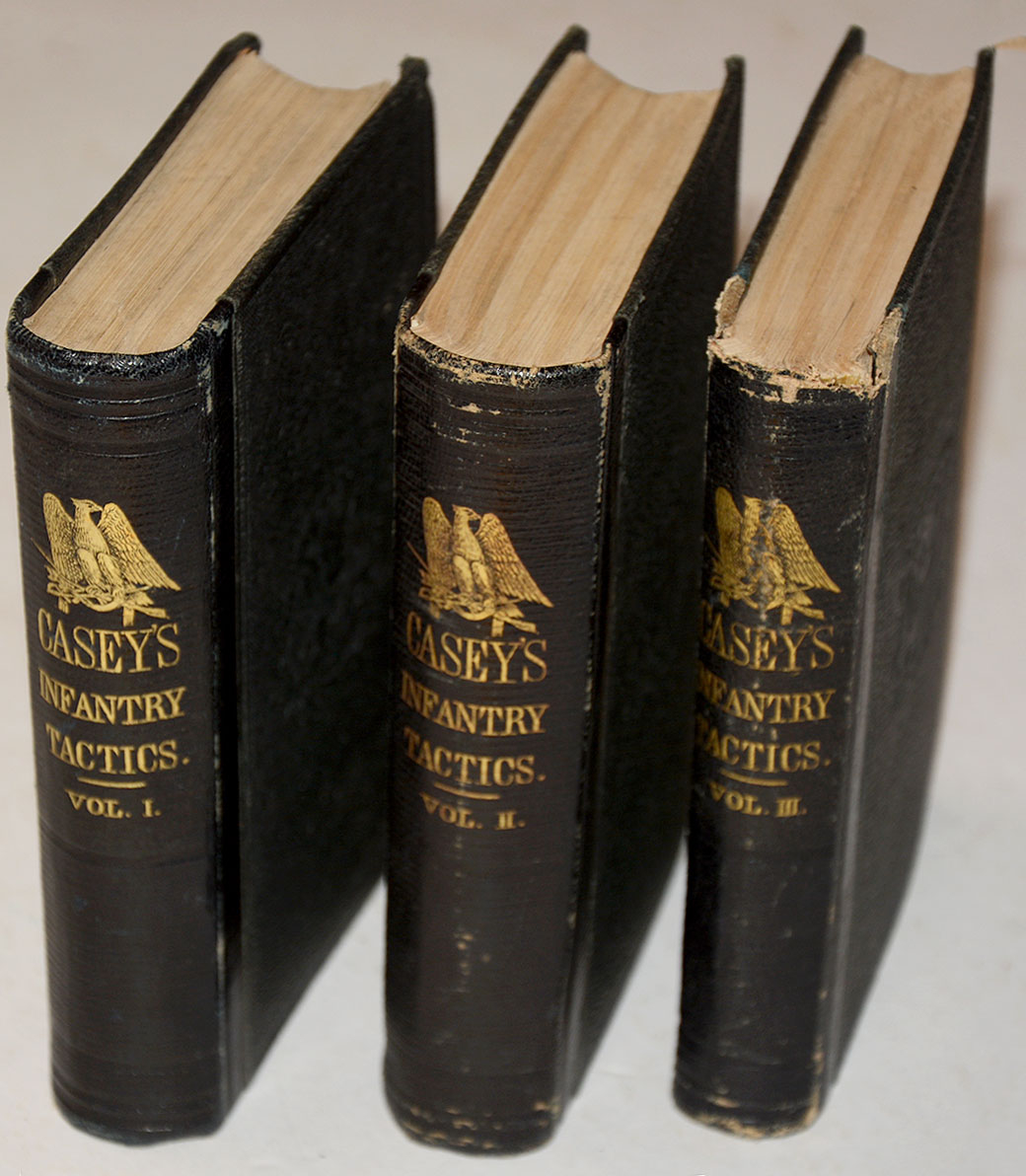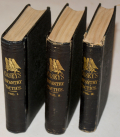site search
online catalog
EXCELLENT CONDITION IDENTIFIED SET OF CASEY’S INFANTRY TACTICS

$395.00 SOLD
Quantity Available: None
Item Code: 1256-142
This is the full three-volume set of Casey’s Infantry Tactics, published by Van Nostrand, in New York in 1862. They bear the book seller’s label of Philp and Solomon, Washington, DC, on the inside of the front cover and are complete with all illustrations, diagrams, plates etc. These are bound in dark green cloth with covers embossed with the arms of the US and the spines gilt blindstamped with the title and volume number beneath an eagle perched on a ribbon and arms. The bindings are tight. The covers show very nice color and surface with just a little light rubbing to the top of spine binding on Volume II and a little more on in the same position on Volume III. Along with Hardee’s tactics this was one of the main instruction manuals used by officers early in the Civil War, working from the bottom-up in instructions for the school of the individual soldier, through the company and regiment.
These are each nicely inscribed in script pencil on the flyleaf, “E. C. Williams / Col. 9th Pa. Cavy.” This is Edward Charles Williams (1820-1900,) a bookbinder and stationer in Harrisburg, PA, before the war, and a merchant and postmaster later. He had militia experience, but also field service in the Mexican War as Captain of Co. G, 2nd PA Volunteers, serving from the landing at Vera Cruz to the capture of Mexico City, reportedly being wounded in the shoulder at Chapultepec, where he raised the flag over the citadel and recovered soon enough to be said to be, “the first to hoist the American flag over the City of Mexico after its capture.” After returning from Mexico he was elected Sheriff of Dauphin County, serving 1850-54 and served as Brigadier General in the Pennsylvania militia from 1854-1861. At the beginning of the war the Governor ordered him to organize Camp Curtin, where he was reportedly the first volunteer sworn in, likely explaining a commission as Brigadier General of PA Volunteers dating April 19,1861. He commanded a brigade “during the three months’ service,” under General Robert Patterson, a major general of Pennsylvania volunteers tasked by Winfield Scott with retaking Harpers Ferry, but whose slow advance and pause after taking Martinsburg enabled Johnston to join Beauregard in time for First Bull Run. Williams mustered out as brigadier general as of July 20, 1861, a day after Patterson was replaced by Banks and a week before he himself was mustered out.
Williams, however, made another attempt at field service, gaining a commission from the Federal government as Colonel of the 9th Pennsylvania Cavalry dating to Oct. 20, 1861, seemingly mustering November 11. The regiment left the state Nov. 20, 1861, and was posted at Jeffersonville, IN, opposite Louisville until January 1862. It was then posted by battalion in different locations in Kentucky until early March, when it moved to Tennessee, also posted there by battalion, with portions of the regiment seeing action at Lebanon against Morgan, with skirmishes at Livingston, Moore’s Hill, Tompkinsville, being reunited for more action at Perryville Oct. 8, 1862, where it lost 10 killed and 27 wounded, but earned praise from Gen. Buell for its steadiness under fire. The regiment seems to have been commanded, however, by the Lieutenant Colonel and Williams is said to have resigned as of October 9, 1862, the day after Perryville. A county history says, “General Williams was at Henderson with his regiment when Buell and Bragg made their march into Kentucky, was ordered to Louisville without delay, and from thence to Crab Orchard, where he prevented Kirby Smith’s cavalry from entering Kentucky at that point. His services in that campaign were indeed arduous. Owing, however, to a question of rank, in which not only he but the other officers in the volunteer service were concerned, he pre-emptorily resigned and returned to Pennsylvania.”
The “question of rank” is unexplained, but since it also involved “the other officers in the volunteer service,” it likely involved assertions of seniority by regular army officers of lesser rank, even though Williams had prior service as brigadier general in PA Volunteers or the “US Volunteers General Staff” as some listings have it. It is also interesting that he acquired a set infantry tactics while still in the cavalry, perhaps showing he hoped for new general’s commission that would put him in command of an infantry brigade, but was frustrated by some occurrence on the eve of Perryville. His service and pension records would likely solve the mystery. Whatever the motive for the books or his resignation, he returned to Pennsylvania and later lived in Chapman, Snyder County, PA, where he died in 1900.
This is a very nice set of a classic Civil War manual with an interesting identification. [sr][ph:L]
~~~~~~~~~~~~~~~~~~~~~~~~~~~~~~~~~~~
THIS ITEM, AS WITH ALL OTHER ITEMS AVAILABLE ON OUR WEB SITE,
MAY BE PURCHASED THROUGH OUR LAYAWAY PROGRAM.
CLICK HERE FOR OUR POLICIES AND TERMS.
THANK YOU!
Inquire About EXCELLENT CONDITION IDENTIFIED SET OF CASEY’S INFANTRY TACTICS
For inquiries, please email us at [email protected]
Most Popular
Historical Firearms Stolen From The National Civil War Museum In Harrisburg, Pa »
Theft From Gravesite Of Gen. John Reynolds »
Fine Condition Brass Infantry Bugle Insignia »
Selection Of Unframed Prints By Don Troiani »
Wonderful Condition Original Confederate-Manufactured Kepi For A Drummer Boy Or Child »
featured item
CIVIL WAR COMMERCIAL FORAGE CAP WITH MAINE BUTTONS AND ASSOCIATED INSIGNIA
Commercial caps were simply those purchased privately rather the issued by the government. They might more or less closely follow contract patterns with the purchaser able to suit his taste and wallet, though an enlisted man, seeking something nicer… (1052-139). Learn More »










